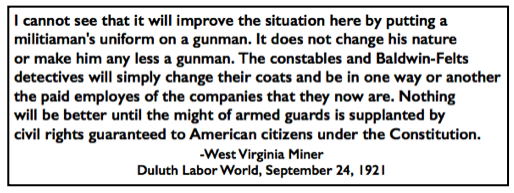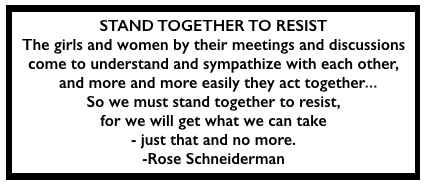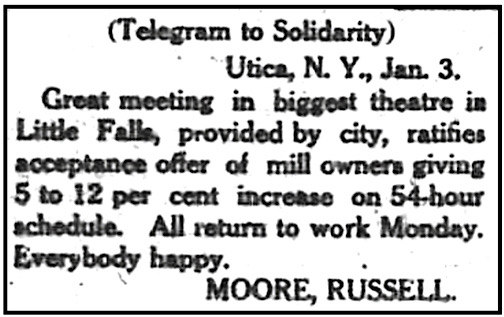 —————
—————
Hellraisers Journal – Saturday February 8, 1913
“Direct Action!” by John Sloan (Government by Gunthug)
From The Masses of February 1913:
Continue reading “Hellraisers Journal: From The Masses: “Direct Action!” by John Sloan”
 —————
—————
Hellraisers Journal – Saturday February 8, 1913
“Direct Action!” by John Sloan (Government by Gunthug)
From The Masses of February 1913:
Continue reading “Hellraisers Journal: From The Masses: “Direct Action!” by John Sloan”
 —————
—————
Hellraisers Journal – Saturday February 7, 1903
Father Thomas Hagerty on Socialism, Scientific and Idealistic
From the International Socialist Review of February 1903:
Socialism Versus Fads.
[-by Father Thomas Hagerty]
———-[Part II of II]
I remember, a little over a year ago, with what amazement I listened to a lecturer on Socialism who, with evident relish, quoted this sentence from Dr. Paul Carus: “The essential feature of existence, of that which presents itself to the senses, is not the material, but the formal; not that which makes it concrete and particular, but that which constitutes its nature and applies generally; not that which happens to be here, so that it is this, but that which makes it to be thus; not its Thisness but its Suchness.”* The discourse itself was vaguely soothing, like James Jeffrey Roche’s Concord love-song:
“Ah, the Ifness sadd’ning,
The Whichness madd’ning,
And the But ungladd’ning
That lie behind!When the signless token
Of love is broken
In the speech unspoken
Of mind to mind!”But imagine the flood of pure white light which such a discourse poured into the brains of the non-Socialists of that audience! At the worst, however, it was Socialism only in the Pickwickian sense and did not roughly antagonize any one’s private beliefs. The lecturer was deeply interested in things occult and could not resist the opportunity, which an audience gathered to hear of Socialism gave him, to expound his favorite doctrines concerning the Nirvana.
On the other hand one frequently meets with the man who prefaces his explanation of Socialism by insisting, like Büchner in matters of science, that the mind must first be emptied of all ideas of God and the supernatural before it is in a proper condition to receive the philosophy of Karl Marx. He wanders far afield to attack this church or that dogma and leaves his hearer under the impression that Socialism is essentially atheistic. He blames all the misery and ignorance in the world upon religion and seems never to have learned that a materialist conception of history puts beyond doubt the fact that the social organism is, in a very large measure, conditioned by its interaction with industrial environment, and that a comparative study of religions shows the influence of economic factors in much of their development. Such a man does positive harm to the cause of Socialism; and he is just as unreasonable and as unscientific as the preacher who insists on basing the science of economics upon his own particular creed.
There is, furthermore, the utterly inconsistent fad of “Christian Socialism,” whose upholders put forth the dogma of the Fatherhood of God as the ground-work of economic science and then proceed to build upon it a superstructure as much out of plumb as the leaning tower of Pisa. They contend that Labor and Capital must recognize their mutual rights,—that, in other words, the lamb must lie down in the lion’s belly and rely upon its coat of wool to protect itself from the searching acid of the gastric juices thereof. They would have men led into the highways of industrial righteousness by the allurement of Gospel texts, unmindful of the fact that nineteen centuries of such blandishment have failed to soften the granite heart of the ruling classes. The New Testament was never designed to serve as a treatise on Socialism any more than it was intended to teach the first principles of Biology. With profound reverence for its beautiful pages, I find it vastly inferior to Huxley and Martin’s “Practical Biology” and Karl Marx’s “Das Kapital,” for the same reason that I find Homer’s “Iliad” inferior to Remsen’s “Chemistry,” for when I want to study either of these sciences I can discover no knowledge of the protoplasm in St. Matthew and no guides to quantative analysis in Homer. This fact, however, does not hinder me from giving full value to the letters of St. Paul nor from appreciating the rhythm and swing of the lines that carry that ancient swashbuckler Achilles.
But when the crazy charge of infidelity is urged against us and a bishop forces a Father McGrady to resign because of his advocacy of Socialism, we may rightly say with Thoreau: “Really, there is no infidelity, nowadays, so great as that which prays, and keeps the Sabbath, and rebuilds the churches.” Surely, it is a flagrant infidelity which denies all Truth which does not bear the approval of a bishop’s imprimatur. It is a subtle atheism which admits the existence of God and then in His Name refuses economic salvation to millions of His creatures; which prays to Heaven and builds churches for worship and then tacitly sanctions the Capitalism which burns the marrow out of orphans’ bones.
 —————
—————
Hellraisers Journal – Friday February 6, 1903
Father Thomas Hagerty on Socialism, Scientific and Idealistic
From the International Socialist Review of February 1903:
Socialism Versus Fads.
[-by Father Thomas Hagerty]
———-[Part I of II]
A LACK of what Whewell so aptly calls “the habit of geometrical thought” is noticeable in much of the confusion which upsets men’s judgment of Socialism. Many persons, earnest in their work for the co-operative common wealth, have only one measure for all problems. From their iron prejudices they forge a Procustean bed upon which they stretch every event too small to fit it and foreshorten every long-limbed fact which has the misfortune to stick over its rigid limits. Thus, as Locke has observed, “some men have so used their heads to mathematical figures, that in giving a preference to the methods of that science, they introduce lines and diagrams into their study of divinity or political inquiries, as if nothing could be known with out them; and others accustomed to retired speculations run natural philosophy into metaphysical notions and the abstract generalities of logic; and how often may one meet with religion and morality treated of in the terms of the laboratory, and thought to be improved by the methods and notions of chemistry?” *
Evidences of the effect of this method abound in every age. Thales of Miletus, the founder of Greek philosophy, based his teachings of Nature on the theory that out of water all things are made. Water is the primal matter and the earth itself floats upon water. The great Philo of Alexandria taught, after the manner of Plato, that the stars are persons endowed with reason and akin to the Divinity. The early churchmen took the Bible as the sole measure of scientific truth and, in consequence, fell into the most childish errors. Many of them denied the sphericity of the earth and the existence of the antipodes. The learned St. Augustine declared that no men live on the other side of the earth because “Scripture speaks of no such descendants of Adam.”
 —————
—————
Hellraisers Journal – Wednesday February 5, 1913
New York, New York – The Garment Strike by Mary Marcy, Photos by Paul Thompson
From the International Socialist Review of February 1913:
THE NEW YORK GARMENT WORKERS
By MARY E. MARCYPhotographs by Paul Thompson, New York.
[Part III of III]
Unlike the Lawrence strike, the strike of the New York garment workers is from the top DOWN; that is the union officials ordered the strike and have held the reins in their hands ever since. Without doubt they are trying to serve the strikers, but it is our opinion that they would build more permanently in permitting the strikers themselves to have the deciding voice in their own affairs; in teaching them self-reliance and class solidarity.
But the workers are finding out many things for themselves. They are thrilling with a new sense of power; they are learning the joy that comes when workers of whatever race or creed fight side by side in a great class struggle. The hope of victory and achievement is in the air and it is doubtful whether they will obey any orders from the union officials if their employers do not grant them appreciable benefits.
The heart of every true Socialist is with the strikers in this fight. We believe that the strike is a valuable form of direct action that teaches working class self-reliance and solidarity better than anything else. It teaches the workers to conduct their own fights. It brings out the class character of all existing social institutions. It teaches above all things, the necessity of revolutionary class unionism.
—————
 —————
—————
Hellraisers Journal – Tuesday February 4, 1913
New York, New York – The Garment Strike by Mary Marcy, Photos by Paul Thompson
From the International Socialist Review of February 1913:
THE NEW YORK GARMENT WORKERS
By MARY E. MARCYPhotographs by Paul Thompson, New York.
[Part II of III]
The thugs employed by the shop bosses have proved very energetic and reliable. They have worked early and late beating up strikers whenever possible, starting trouble and blaming it on the workers, while the police stood by (or took a hand) to see that nobody attacked or injured them.
During the first week in January the union officials conferred with the employers relative to a settlement of the strike, but the New York Call reports that all negotiations were broken off when the employers insisted upon a return of the strikers to the shops pending an investigation of the conditions in the trade by a special commission to be appointed for that purpose. The union officials declared that under no circumstances would “they order the men to return to work” pending an investigation or arbitration of their demands.
As the pickets began to suffer at the hands of the company guards, it was decided to take a lesson from the strikers at Lawrence, Mass., and chain picketing was employed for the first time in New York City.
Ten thousand pickets were asked to report each day, starting to work on the “Chain Picket Line” at 5 :00 o’clock in the morning, to pass constantly in a steady stream of pedestrians before the strikebound shops.
On the day of the inauguration of the Chain Picket plan, the unions held various meetings which were well attended by the strikers. Hugh Frayne urged a general strike in every branch of the needle and garment industries, promising the support of the A. F. of L. while Abe Cahan closed one meeting begging the strikers to be true to the American Federation of Labor. He urged them to carry an A. F. of L. card in one pocket and a Socialist party card in the other (that is to work for class organization on one side and craft division on the other.)
This is very different from the calls of the Industrialists, all of whom insist upon a CLASS UNION card on the industrial field and a Socialist party card to represent their class interests upon the political field.
 —————
—————
Hellraisers Journal – Monday February 3, 1913
New York, New York – The Garment Strike by Mary Marcy, Photos by Paul Thompson
From the International Socialist Review of February 1913:
[Part I of III]
A WALKOUT which may yet involve every garment worker in the nation, was started in New York City, December 30th, when scores of thousands of men and women employed in the garment industries responded to the call issued by the United Garment Workers of America and deserted the shops and benches where they had toiled for years.
The response to the strike call was so great that the union officials declared the union was a great deal stronger than they had believed. One thousand five hundred volunteer red scouts, who were picked to carry the official strike declaration, were on the job at 4:00 o’clock in the morning ready to start out with bundles of strike orders to be distributed in all sections of the Lower East Side. Before night over 100,000 men, women and children had taken their working paraphernalia home to begin the good fight.
The garment workers are striking for:
The abolition of the subcontracting system.
The abolition of foot power.
That no work be given out to be done in tenement houses.
Overtime to be paid for at the rate of time and one half, double time for holidays.
A forty-eight hour work week.
A general wage increase of 20 per cent for all the workers in the garment industry.The following scale of wages:
Operators-First class, sewing around coats, sewing in sleeves, and pocket makers, $25 per week; second class, lining makers, closers and coat stitchers, $22; third class, sleeve makers and all other machine workers, $16.
Tailors-First class, shapers, underbasters and fitters, $24; second class, edge basters, canvas basters, collar makers, lining basters and bushelers, $21; third class, armhole basters, sleeve makers, and all other tailoring, $17.
Pressers-Bushel pressers, $24; regular pressers, second class, $24; underpressers and edge pressers, $18.
Women and Child Workers-Button sewers and bushel hands, $12; hand buttonhole makers, first class, 3½ cents; second class, sack coats, 2½ cents; feller hands, not less than $10 a week.
 —————
—————
Hellraisers Journal – Sunday February 2, 1913
Mr. Block by Ernest Riebe Now Found in Pages of the Spokane Industrial Worker
From the International Socialist Review of February 1913:
 -from Solidarity of January 11, 1913
-from Solidarity of January 11, 1913
—————
Hellraisers Journal – Saturday February 1, 1913
Fourteen Strikers, Organizers and Speakers of Little Falls Strike Remain in Jail
From the International Socialist Review of February 1913:
IN the Herkimer County jail at Herkimer, N. Y., are fourteen strikers, organizers and speakers-Legere, Bocchini, Vaughn, Hirsh, Lesnicki, Wladya, Morlando, Preta, Scitrona, Bianco, Flamena Cornacchio, Furillo and Capuano. They must stand trial on serious charges because the authorities of Little Falls and Herkimer county hold that:
Ten persons who gather together during a strike constitute a “riot.”
An open-air meeting in which quotations from the Bible, Declaration of Independence and Constitution of the United States are read constitutes “an unlawful assemblage.”
Speakers who encourage strikers to stand firm but urge them to be peaceful and orderly are guilty of “inciting to riot.”
Organizers who are present in an orderly assemblage which is broken up by police and in which two detectives are hurt by unknown persons must face long terms in jail for “assault in the first degree.”
Workingmen who are members of a strike committee are conspirators and should be locked up where their influence will not be felt.
If convictions are obtained in these cases then the working class of America might as well abandon all agitation and education both for political and economic action unless they are prepared to serve from one to ten years in the penitentiary.
The Little Falls strike is over, but the big fight has just begun. The commonest rights of human beings and citizens have once more been annulled and spit upon by the capitalist class and their legal lackeys. Are they going to be allowed to get away with it? These cases were originally set for the second week in January, but they may be continued. Meantime send your protests to Governor Sulzer at Albany, N. Y., who says he is the “workingman’s friend”; to District Attorney Farrell at Ilion, N. Y., and Mayor Shall at Little Falls, N. Y. It is time the voice of labor be heard.
—————
[Emphasis added.]